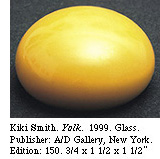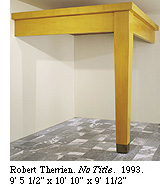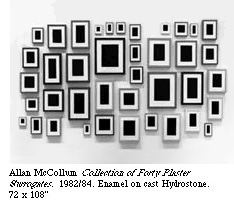|
A grand scale Museum of Modern Art exhibit at the State Museum skews the perspective
The focus of Shapiro's monochromatic sculpture is a miniature house at the end of a long shelf; Tone was considering how best to light and present the piece. Tone also unpacked a well-protected baby food jar. Inside it was a human figure tiny enough to fit on a fingertip. But not everything within Tone's reach was small. Her desk — actually nothing more than a folding table, a chair and stack of boxes — hunkered in the shade of Robert Therrien's "No Title," the corner of a 9-foot-tall table that appeared to be jutting out of a corner in the Albany museum's West Gallery.
"It's not a thematic show per se," said Tone, an assistant curator in MoMA's Department of Painting and Sculpture. "It's about how scale was used as an expressive tool by these artists, rather than about a specific subject." "Strangely Familiar" grew in part out of "Actual Size," a similarly scale-themed show that Tone curated for MoMA, and an essay on scale she wrote for MoMA's publication Modern Contemporary. "So many artists are using magnification and miniaturization today," she said. "These artists make work that demands the participation of the viewer and a relationship to the viewer's body in a very direct way."
Tone approached each of the four "rooms" of the West Gallery differently, breaking up the playfulness of perspective into loose riffs on portraiture, domestic still life, media manipulation and old-fashioned illusionism. As a viewer enters the gallery, he or she is nearly overwhelmed by Close's "Robert/104,072," a giant head-and-shoulders photo of a benign, smiling man. Or is it? "Robert" is actually a painting — and a painstakingly created one, at that. Close mapped out a grid of 104,072 squares (hence the title) and carefully painted in each block one dot at a time. Allan McCollum and Laurie Simmons' "Actual Photos" takes Close's magnification of the mundane even further.
Close, McCollum and Simmons, Tone said, "all approach the tradition of portraiture through a conceptual, scale-based system." "There's a whole world out there in literature that deals with issues of magnification and miniaturization," she said, citing Jonathan Swift's "Gulliver's Travels" and Lewis Carroll's "Alice in Wonderland" as two classics of the genre. "We have been fascinated with scale disarray for a long, long time and we still are. Inverting the expected dimensions of things makes us look at our world again."
More tables and chairs are just around the corner, along with beds, picture frames and kitchen staples. Virtually everything in Tone's domestic scene is in standard scale, but little of it is what it seems. Gober's "Untitled" bed and Katharina Fritsch's "Black Table with Table Ware" look like household items (or even examples of Marcel Duchamp's "ready-mades"), but Tone insists that part of what makes them art is the fact the creators fashioned every element by hand. Gober, who is also represented by "Cat Litter" and "Newspaper," cut the wood for his bed, sewed the sheets, stuffed the pillow, wove the blanket and imbued the whole thing with enough childhood memories to exhaust a psychiatrist.
Such manipulations clearly delight Tone, who has also included Robert Watt's chrome-plated cabbages, Kiki Smith's glass egg yolks, and Koons' "Baccarat Crystal Set," which is cast from stainless steel. Mass-produced Warhol's famous Brillo and Heinz boxes dominate Tone's collection of works referencing the realms of media and advertising. They mimic mass-produced containers, but they were also created with the same silk-screen process used to make the originals.
It's represented at the museum by a sleek, brushed aluminum trailer that goes nowhere. Zittel doesn't plan to escape in her vehicle so much as into it. Contained within the metal shell is a grotto inspired by Zittel's childhood memory of a trip to a similar haven made for King Ludwig II of Bavaria. Expectations Tone truly plays with expectations in the final leg of the "Strangely Familiar" journey.
But Richard Artschwager's "Untitled" and Peter Fischli and David Weiss' "Things from the Room in the Back" are art, too. Artschwager's cumbersome wooden crates might seem to be intended for the loading dock instead of the gallery. And Fischli and Weiss' messy mix of boxes, boards, buckets of paint and old film canisters ask only to be taken for what they are: remarkably realistic-looking detritus carved from polyurethane and meticulously painted to look like the genuine article. "There are so many things we overlook, things we don't value, things that just belong to our everyday life," Tone said. "They're so familiar they become invisible, and in this show they are rendered visible again."
SIZE MATTERS "STRANGELY FAMILIAR: |

 Tone is the curator of "Strangely Familiar: Approaches to Scale in the Collection of the Museum of Modern Art." The exhibition, the 10th installment in the Fleet Great Art Series, includes works from Andy Warhol, Chuck Close, Robert Gober, Jeff Koons, Edward Ruscha and others.
Tone is the curator of "Strangely Familiar: Approaches to Scale in the Collection of the Museum of Modern Art." The exhibition, the 10th installment in the Fleet Great Art Series, includes works from Andy Warhol, Chuck Close, Robert Gober, Jeff Koons, Edward Ruscha and others.
 Loose riffs
Loose riffs
 McCollum and Simmons used the powerful lens of a medical microscope to create macro portraits of toy train figures like the one in Tone's jar. The effect, shown in a group of 12 pictures, is eerie, unsettling and beautiful. Amplified, the globby, painted faces become grotesque staring back at the viewer in serene decomposure.
McCollum and Simmons used the powerful lens of a medical microscope to create macro portraits of toy train figures like the one in Tone's jar. The effect, shown in a group of 12 pictures, is eerie, unsettling and beautiful. Amplified, the globby, painted faces become grotesque staring back at the viewer in serene decomposure.
 Not what it seems
Not what it seems
 The frames included in McCollum's "40 Plaster Surrogates" hold no pictures. They also blur the line between painting, sculpture and performance art: The artist suggests that while viewing the collection patrons are "just experiencing themselves walking around the gallery looking at art."
The frames included in McCollum's "40 Plaster Surrogates" hold no pictures. They also blur the line between painting, sculpture and performance art: The artist suggests that while viewing the collection patrons are "just experiencing themselves walking around the gallery looking at art."
 Warhol constantly toyed with the familiar and the commercial in his art. Andrea Zittel's "A-Z Escape Vehicle" series does the same.
Warhol constantly toyed with the familiar and the commercial in his art. Andrea Zittel's "A-Z Escape Vehicle" series does the same.
 The last quarter of the gallery looks unfinished, as if the staff had forgotten to clean up after mounting the rest of the show.
The last quarter of the gallery looks unfinished, as if the staff had forgotten to clean up after mounting the rest of the show.